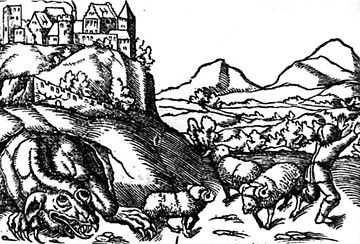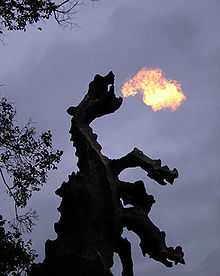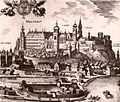Wawel Dragon

The Wawel Dragon (Polish: Smok Wawelski), also known as the Dragon of Wawel Hill, is a famous dragon in Polish folklore. His lair was in a cave at the foot of Wawel Hill on the bank of the Vistula River. Wawel Hill is in Kraków, which was then the capital of Poland. In some stories the dragon lived before the founding of the city, when the area was inhabited by farmers.
Wawel Cathedral and Kraków's Wawel Castle stand on Wawel Hill. The cathedral features a statue of the Wawel dragon and a plaque commemorating his defeat by Krakus, a Polish prince who, according to the plaque, founded the city and his palace over the slain dragon's lair. The dragon's cave below the castle is now a popular tourist stop.[1][2]
History
The oldest known account of the story comes from 12th century, in the work by Wincenty Kadłubek.[3]
A popular version of the Wawel Dragon tale takes place in Kraków during the reign of King Krakus, the city's legendary founder. Each day the evil dragon would beat a path of destruction across the countryside, killing the civilians, pillaging their homes and devouring their livestock. In many versions of the story, the dragon especially enjoyed eating young maidens, and could only be appeased if the townsfolk left a young girl in front of its cave once a month. The King certainly wanted to put a stop to the dragon, but his bravest knights fell to its fiery breath. In the versions involving the sacrifice of young girls, every girl in the city was eventually sacrificed except one, the King's daughter Wanda. In desperation, the King promised his beautiful daughter's hand in marriage to anyone who could defeat the dragon. Great warriors from near and far fought for the prize and failed. One day a poor cobbler's apprentice named Skuba accepted the challenge. He stuffed a lamb with sulphur and set it outside the dragon's cave. The dragon ate it and soon became incredibly thirsty. He turned to the Vistula River for relief and drank and drank. But no amount of water could quench his aching stomach, and after swelling up from drinking half the Vistula river, he exploded. Skuba married the King's daughter as promised, and they lived happily ever after.
Modern times
- In 1970 a metal sculpture of the Wawel Dragon designed by Bronisław Chromy was placed in front of the dragon's den. The dragon has seven heads, but frequently people think that he has one head and six legs. To the amusement of children, it noisily breathes fire every few minutes, thanks to a natural gas nozzle installed in the sculpture's mouth.
- The street leading along the banks of the river leading towards the castle is ulica smocza, which translates as "Dragon Street".
Dragon in culture
- Wawel Dragons (Gold, Silver, Bronze Grand Prix Dragons and Dragon of Dragons Special Prize) are awards, usually presented at Kraków Film Festival in Poland
- The Dragon (as "The Beast of Kraków") appeared in the eighth issue of a comic book series Nextwave from Marvel Comics (written by Warren Ellis and drawn by Stuart Immonen).
See also
![]() Media related to Wawel Dragon at Wikimedia Commons
Media related to Wawel Dragon at Wikimedia Commons
![]() Media related to Smok Wawelski at Wikimedia Commons
Media related to Smok Wawelski at Wikimedia Commons
References
- ↑ The Dragon of Wawel Hill - Smok Wawelski. Icbleu.org. Retrieved July 27, 2012.
- ↑ The Dragon of Wawel. Michael Resch at NSW AMES. Retrieved July 27, 2012.
- ↑ Mistrz Wincenty tzw. Kadłubek, "Kronika Polska", Ossolineum, Wrocław, 2008, isbn = 83-04-04613-X
External links
- The Legend of Wawel's Dragon
- The Dragon of Wawel and the Jewish Prophet Daniel.
- Parada Smokow: The Parade of Dragons
| ||||||||||||||||||||
| ||||||||||||||||||||


